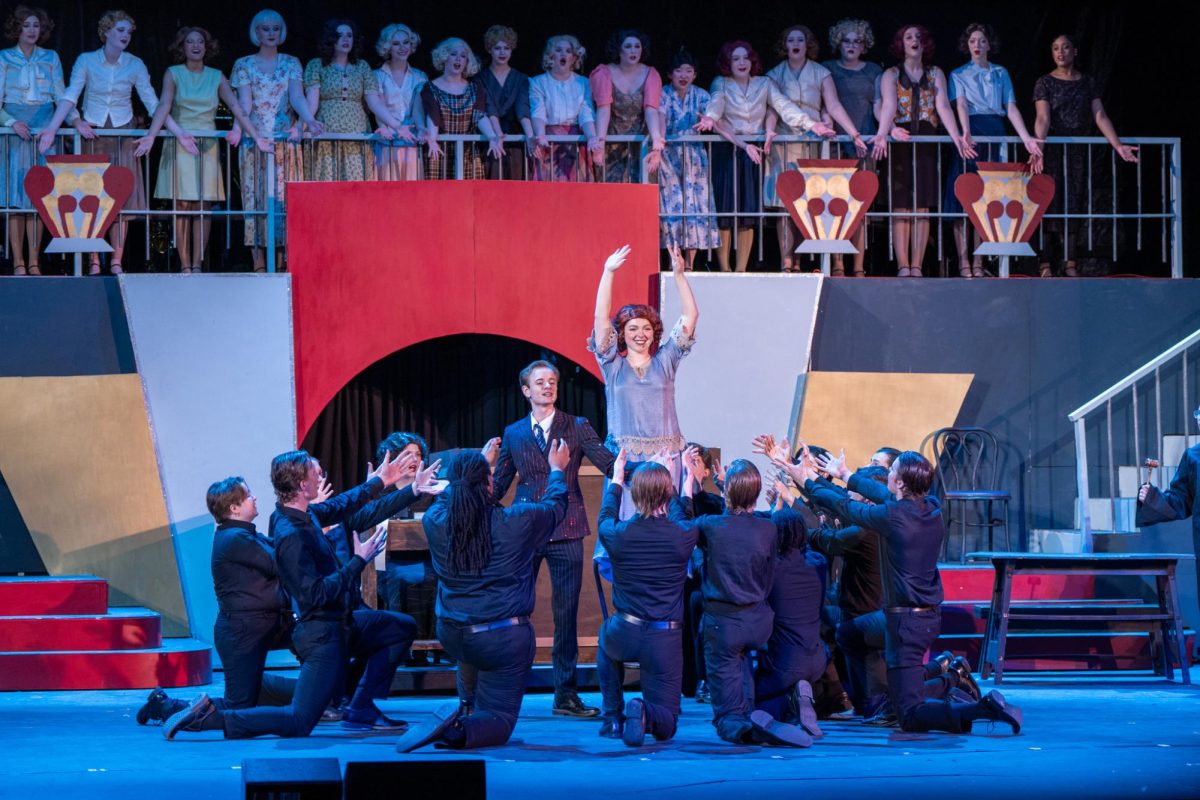It was a great disappointment to discover that after turning on the Spotify playlist for “Chicago: The Musical” and scrolling to “We Both Reached For The Gun,” I was met not with the voices of seniors Gaby Bannister and Elias Gregory but of the comparatively rather disappointing Renee Zellweger and Richard Gene.
Bannister masterfully played Roxie Hart, a woman on trial for murdering her secret lover, while Gregory’s lyricism as her greasy lawyer was integral to what made the musical so stellar.
While watching the Drama Club’s performance, that song was when it clicked that this was going to be a truly special performance, and not just for EHS. The scene wasn’t just a song; it was living, breathing propaganda unfolding on stage. The way Billy crafted and sold Roxie’s story was both brilliantly theatrical and deeply unnerving, leaving you to grapple with the power of a well-spun lie – and how easily journalists will eat it up.
There’s something ironic about the time in which the musical was performed. Where else have we seen a story of a murder suspect turned into an intricate web sold to the press for the audience’s entertainment?
Don’t answer that – it happens everywhere, all the time, and it’s why a musical originally written nearly 100 years ago can be performed so eloquently by high schoolers who are impacted by what happens when that story happens outside the auditorium.
It should come as no surprise to those who’ve followed Edwardsville’s history of outstanding musicals that Chicago was sure to be a hit. But the performances of Bannister, Gregory, Liv Warner as Velma Kelly and Charlie Kurzym as Roxie’s husband Amos, made it one of EHS’s best musicals to date.
The singers hit every note, specifically in songs like “My Own Best Friend” and Amos’s soliloquy “Mister Cellophane” and the costumes were sure to razzle dazzle the audience.
And that’s not even to mention the supporting cast, whose participation in many of the dance numbers further served as a benefit to the whole musical. No individual actor can make a show, but the performances of the murderers in the beginning, journalists in the middle and jury in the end all certainly elevated the singing and acting of the main cast.
While everyone involved in its production earned well-deserved bragging rights, the tech crew provided a backdrop to a truly phenomenal musical that certainly didn’t go unnoticed.
From the newspaper backdrop with the face of Roxie Hart plastered on it that the lights slowly changed from a faded Yellow Pages-stained look to a phosphorescent blue, to the shimmering red, gold and silver streamers that dominated the scene during “Razzle Dazzle,” every aspect made it feel like you might as well be on Broadway.
If the puppeteer scene didn’t quite hit the nail about the American court of law being merely a spectacle hard enough, then each one of the balls Billy juggled while jesters performed and twirled hula-hoops made sure to firmly smash the nail to pieces.
As the jury leaned in to acutely listen to Roxie taking the witness stand, then replaying the murder of Fred Casely – which was a treat to watch as sophomore Mark Hill played dead from being shot on stage – the narrative wrapped up, and it became clear that facts and evidence came second to feelings.
Chicago told the poignant narrative of an America with murderers walking free due to a convincing enough argument – perhaps being pregnant with an imaginary baby. It was juxtaposed with those who get exorbitant sentences because they couldn’t get the support of the newspapers and the public.
It’s impressive that a crew of teenagers so far mostly unaffected by the adult life the musical portrayed gave such a convincing performance. Watchers could’ve mistaken them for people who been born, lived and died all before the advent of color TVs.
Watching senior Ariel Mitchell as Matron Mama Morton cycle through newspapers covering her favorite murderers in the cell block who get the most press was extraordinarily stirring to the audience.
They watched Velma’s case get pushed out of the front page, and the court schedule, by Roxie’s case. And then Roxie’s story was cycled out again at the end to complete the wonderfully told circular narrative. One that can be told over and over every year since it was first written a century ago, yet none better than EHS.


